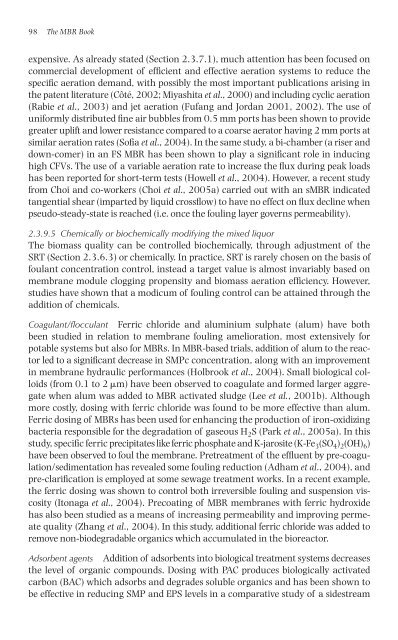The MBR Book: Principles and Applications of Membrane
The MBR Book: Principles and Applications of Membrane
The MBR Book: Principles and Applications of Membrane
Create successful ePaper yourself
Turn your PDF publications into a flip-book with our unique Google optimized e-Paper software.
98 <strong>The</strong> <strong>MBR</strong> <strong>Book</strong><br />
expensive. As already stated (Section 2.3.7.1), much attention has been focused on<br />
commercial development <strong>of</strong> efficient <strong>and</strong> effective aeration systems to reduce the<br />
specific aeration dem<strong>and</strong>, with possibly the most important publications arising in<br />
the patent literature (Côté, 2002; Miyashita et al., 2000) <strong>and</strong> including cyclic aeration<br />
(Rabie et al., 2003) <strong>and</strong> jet aeration (Fufang <strong>and</strong> Jordan 2001, 2002). <strong>The</strong> use <strong>of</strong><br />
uniformly distributed fine air bubbles from 0.5 mm ports has been shown to provide<br />
greater uplift <strong>and</strong> lower resistance compared to a coarse aerator having 2 mm ports at<br />
similar aeration rates (S<strong>of</strong>ia et al., 2004). In the same study, a bi-chamber (a riser <strong>and</strong><br />
down-comer) in an FS <strong>MBR</strong> has been shown to play a significant role in inducing<br />
high CFVs. <strong>The</strong> use <strong>of</strong> a variable aeration rate to increase the flux during peak loads<br />
has been reported for short-term tests (Howell et al., 2004). However, a recent study<br />
from Choi <strong>and</strong> co-workers (Choi et al., 2005a) carried out with an s<strong>MBR</strong> indicated<br />
tangential shear (imparted by liquid crossflow) to have no effect on flux decline when<br />
pseudo-steady-state is reached (i.e. once the fouling layer governs permeability).<br />
2.3.9.5 Chemically or biochemically modifying the mixed liquor<br />
<strong>The</strong> biomass quality can be controlled biochemically, through adjustment <strong>of</strong> the<br />
SRT (Section 2.3.6.3) or chemically. In practice, SRT is rarely chosen on the basis <strong>of</strong><br />
foulant concentration control, instead a target value is almost invariably based on<br />
membrane module clogging propensity <strong>and</strong> biomass aeration efficiency. However,<br />
studies have shown that a modicum <strong>of</strong> fouling control can be attained through the<br />
addition <strong>of</strong> chemicals.<br />
Coagulant/flocculant Ferric chloride <strong>and</strong> aluminium sulphate (alum) have both<br />
been studied in relation to membrane fouling amelioration, most extensively for<br />
potable systems but also for <strong>MBR</strong>s. In <strong>MBR</strong>-based trials, addition <strong>of</strong> alum to the reactor<br />
led to a significant decrease in SMPc concentration, along with an improvement<br />
in membrane hydraulic performances (Holbrook et al., 2004). Small biological colloids<br />
(from 0.1 to 2 �m) have been observed to coagulate <strong>and</strong> formed larger aggregate<br />
when alum was added to <strong>MBR</strong> activated sludge (Lee et al., 2001b). Although<br />
more costly, dosing with ferric chloride was found to be more effective than alum.<br />
Ferric dosing <strong>of</strong> <strong>MBR</strong>s has been used for enhancing the production <strong>of</strong> iron-oxidizing<br />
bacteria responsible for the degradation <strong>of</strong> gaseous H 2S (Park et al., 2005a). In this<br />
study, specific ferric precipitates like ferric phosphate <strong>and</strong> K-jarosite (K-Fe 3(SO 4) 2(OH) 6)<br />
have been observed to foul the membrane. Pretreatment <strong>of</strong> the effluent by pre-coagulation/sedimentation<br />
has revealed some fouling reduction (Adham et al., 2004), <strong>and</strong><br />
pre-clarification is employed at some sewage treatment works. In a recent example,<br />
the ferric dosing was shown to control both irreversible fouling <strong>and</strong> suspension viscosity<br />
(Itonaga et al., 2004). Precoating <strong>of</strong> <strong>MBR</strong> membranes with ferric hydroxide<br />
has also been studied as a means <strong>of</strong> increasing permeability <strong>and</strong> improving permeate<br />
quality (Zhang et al., 2004). In this study, additional ferric chloride was added to<br />
remove non-biodegradable organics which accumulated in the bioreactor.<br />
Adsorbent agents Addition <strong>of</strong> adsorbents into biological treatment systems decreases<br />
the level <strong>of</strong> organic compounds. Dosing with PAC produces biologically activated<br />
carbon (BAC) which adsorbs <strong>and</strong> degrades soluble organics <strong>and</strong> has been shown to<br />
be effective in reducing SMP <strong>and</strong> EPS levels in a comparative study <strong>of</strong> a sidestream



